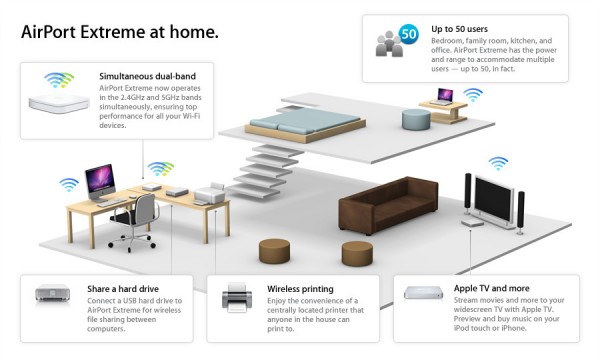
For a router option, the AirPort Extreme Base Station exudes a familiar Apple air about it, with its easy setup utility, user-friendliness, and functionalities that deliver topnotch performance as packaged. Probably the only downside to this router is its being a tad more expensive than similar Windows-based rivals. Mac advocates with Intel-run Apple computers will do well using AirPort Extreme, although they will have to shell out a hefty 179 dollars to enjoy its incredible features. Presumably, the router is also compatible with Windows, with bundled installation software for the Vista OS versions in PCs, but those with tighter budgets and those with less recent 802.11 Wi-Fi devices may want to pursue comparable Windows-based options to better suit their resources.
This router has a form factor that is decidedly Apple with its clean, crisp appearance. With dimensions of 1.3 by 6.5 inches, AirPort Extreme is almost the size of an Apple TV media extender, and looks very much like the old Apple Minis. The unit maintains its smart-looking exterior by omitting the use of external antennas, making it one of the handsomest MIMO routers in the market. A single lamp on the front of the device flashes green to denote its network readiness. Looking at the backside of the device, the user will find an Ethernet WAN port that allows a DSL or cable modem speed of up to 100 Mbps. There are also three LAN ports with the same speed available, which are two more than what the previous model has, plus the obligatory small reset button. A USB 2.0 port is also included to let users plug in an external hard drive or printer directly, or a hub if wishing to connect several of these devices simultaneously.
Installation is simple, even more so for previous users of the 802.11g Airport Extreme released earlier by Apple. Novices are spared setup headaches by a simplified Wi-Fi network manual that clearly demonstrates the correct way to connect and run the device. The complete package includes the unit itself, a power adapter, the manual, plus software installers for both Windows and Mac platforms. Don’t bother looking for the usual extra cables in most Wi-Fi routers, because the set does not include any, even one for connecting the router to a modem.
The actual installation will start with connecting the unit itself and plugging it into an electrical socket, after which the user will need to install the appropriate software driver bundled in the package for network management. Once the software is fully-installed in the computer, a good idea would be for the user to download its latest update from Apple’s support website to ensure that the system will run smoothly. To connect the router to old Macs that have Intel’s Core 2 Duo requires enabling the Wi-Fi client cards to work using 802.11n, which is mercifully easy to do via an available utility in the bundled software.
With a fairly easy step-by-step setup, AirPort Extreme edges out its closest Windows-based competition just so in terms of hassle-free installation, with perhaps holding a little more advantage in that its utility is virtually foolproof. Using the guide, individuals will find instructions for setting up in as plain wording as possible, and novices can have their systems operational well within five minutes. An additional utility in the software disc is one for external hard drive management, should one is docked via the USB port.
The system is sparsely decked out with network options, but those with a fair amount of technical know-how can find lots of tweaking opportunities to get their hands busy with. The unit operates in one of two mixed 802.11 modes, either of which is usable connecting to less capable Wi-Fi devices. Those blessed with an all-802.11n device lineup can take advantage of enabling a pure 802.11n mode that operates over the 2.4GHz frequency, or the relatively interference-free 5GHz. Using the latter is optimal for smoother data transfer, since most electronics like cordless phones also use the 2.4GHz frequency as much as Wi-Fi platforms.
Securing those transfers would be a 40-bit and 128-bit WEP and WPA, WPA2 security standard, which stands for Wired Equivalent Privacy and Wi-Fi Protected Access, respectively. Additional security measures include options to set up a Media Access Control address filter and a NAT, or network address translation, firewall. Partial access can also be implemented using an available feature for managing time-based network access according to a set schedule. While the settings interface is quite straightforward, one aspect that may prove annoying to some is the mandatory rebooting done to the unit itself for a new setting to become effectively implemented.
AirPort Extreme leaves 802.11g rivals far behind with its impressive range and speed. However, the router’s performance still falls short on its promised capabilities. This is, however, typical of routers and access points, and in extension all Wi-Fi devices, especially those under the Draft N mode, with AirPort Extreme performing slightly better. With regard to reception, the router works rather well from as far as fifty feet away in tests using both mixed and n-only modes. Those tests also proved that AirPort Extreme can accommodate several clients simultaneously with ease, with the client devices accessing files from both the computer and a docked external hard drive. Beyond fifty feet the signal becomes progressively weaker, with a maximum operable range topping at around 100 feet.
Further testing done confirmed that the setup can transfer 100 MB worth of content in about 36 seconds using the device in a mixed mode, with a 500-MB transfer completing in less than three minutes. Switching to the 5GHz frequency in n-only mode dramatically speeds up things, with the same 100- and 500-MB transfers finishing in a scant 17 seconds and one minute, 46-seconds, respectively. These results speaks volumes on what this nifty little gadget can do.










“Switching to the 5GHz frequency in n-only mode dramatically sped up things, with the same 100- and 500-MB transfers finishing in a scant 17 seconds and one minute, 46-seconds, respectively” i believe cordially. Thanks for sharing.
Apple always makes it easy to run.